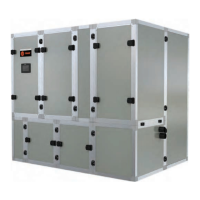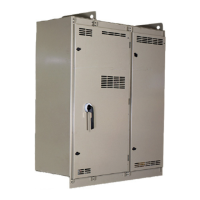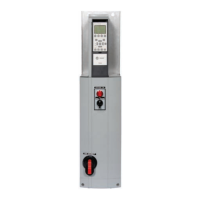66
PKG-SVX027D-EN
Figure 50. Unit filter sizes
24 x 20 24 x 20 24 x 20 24 x 20
24 x 20 24 x 20 24 x 20 24 x 20
24 x 20 24 x 20 24 x 20 24 x 20
Inspecting and Cleaning the
Drain Pan
Check the condensate drain pan and drain line to ensure
that the condensate drains properly at least every six
months or as dictated by operating experience.
If evidence of standing water or condensate overflow
exists, take steps to identify and remedy the cause
immediately. Refer to the “troubleshooting section of this
manual,” p. 76 for possible causes and solutions.
WARNING
Hazardous Voltage w/Capacitors!
Failure to disconnect power and discharge capacitors
before servicing could result in death or serious
injury.
Disconnect all electric power, including remote
disconnects and discharge all motor start/run
capacitors before servicing. Follow proper lockout/
tagout procedures to ensure the power cannot be
inadvertently energized. For variable frequency drives
or other energy storing components provided by
Trane or others, refer to the appropriate
manufacturer’s literature for allowable waiting periods
for discharge of capacitors. Verify with a CAT III or IV
voltmeter rated per NFPA 70E that all capacitors have
discharged.
Clean drain pans using the following procedure:
1. Disconnect all electrical power to the unit.
2. Don the appropriate personal protective equipment
(PPE).
3. Remove all standing water.
4. Use a scraper or other tools to remove and solid matter.
Remove solid matter with a vacuum device that utilizes
high efficiency particulate arrestance (HEPA) filters with
a minimum efficiency of 99.97% at 0.3 micron particle
size.
5. Thoroughly clean the contaminated area(s) with a mild
bleach and water solution or an EPA-approved sanitizer
specifically designed for HVAC use. Carefully follow the
sanitizer manufacturer’s instructions regarding product
use.
6. Immediately rinse the drain pan thoroughly with fresh
water to prevent potential corrosion from the cleaning
solution.
7. Allow the unit to dry thoroughly before putting the
system back into service.
8. Properly dispose of all contaminated materials and
cleaning solution.
Compressors
Scroll Compressor Failure Diagnosis and
Replacement
If compressor failure is suspected, refer to COM-SVN01 for
detailed information regarding compressor failure diagnosis
and replacement of scroll compressors.
Refrigerant System
If refrigerant system repair is required, Leak Test, Brazing
and Evacuation Procedures are described.
Preliminary charging is described in the Installation–
Mechanical section, “Preliminary Refrigerant Charging,” p.
36 and final charging is described in the Startup section,
“Final Refrigerant Charge,” p. 63.
Refrigerant systems that have been opened must have
filter driers replaced and complete leak test and evacuation
before recharging. Unit is equipped with replaceable filter
core option for easy maintenance.
Refrigerant Leak Test Procedure
WARNING
Confined Space Hazards!
Failure to follow instructions below could result in
death or serious injury.
Do not work in confined spaces where refrigerant or
other hazardous, toxic, or flammable gas may be
leaking. Refrigerant or other gases could displace
available oxygen to breathe, causing possible
asphyxiation or other serious health risks. Some
gases may be flammable and/or explosive. If a leak in
such spaces is detected, evacuate the area
immediately and contact the proper rescue or
response authority.
WARNING
Explosion Hazard!
Failure to follow safe leak test procedures below
could result in death or serious injury or equipment or
property-only-damage.
Never use an open flame to detect gas leaks. Use a
leak test solution for leak testing.
Maintenance

